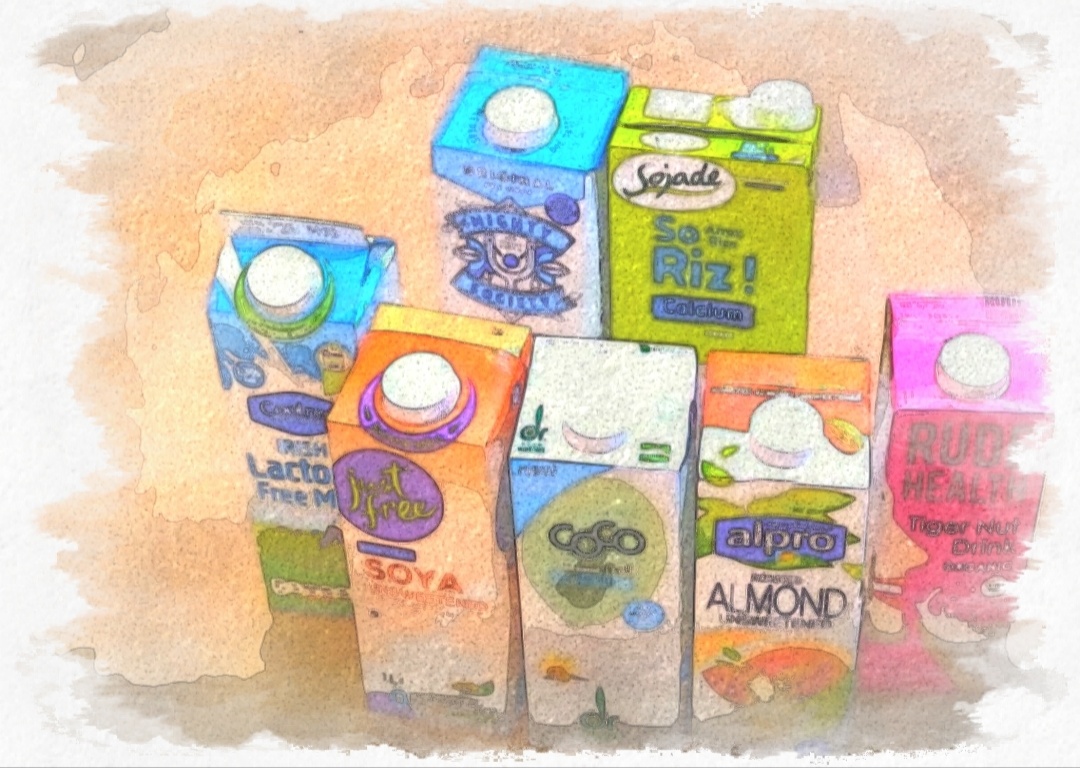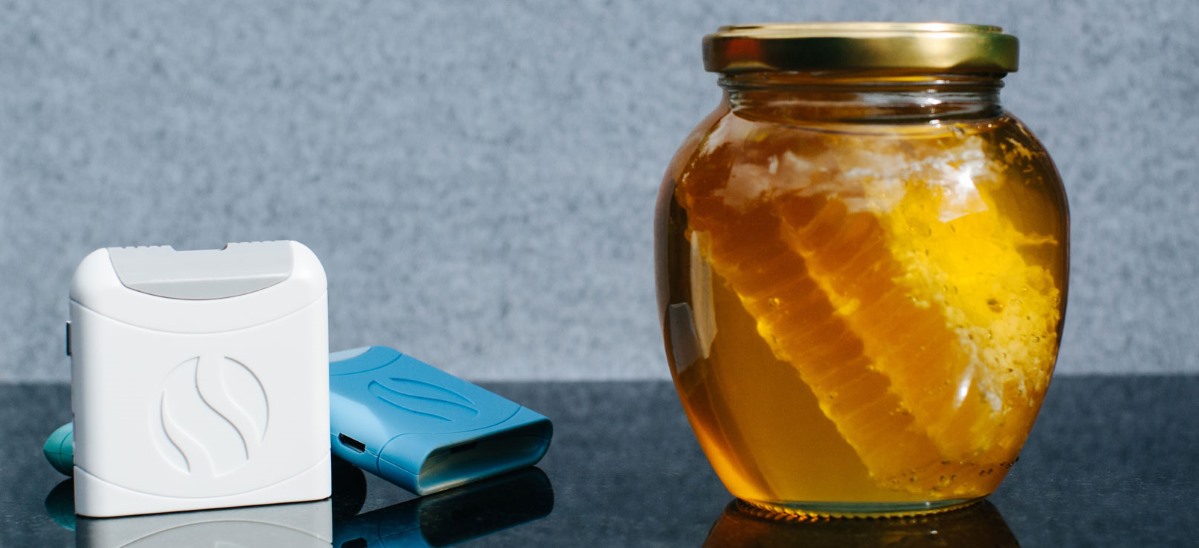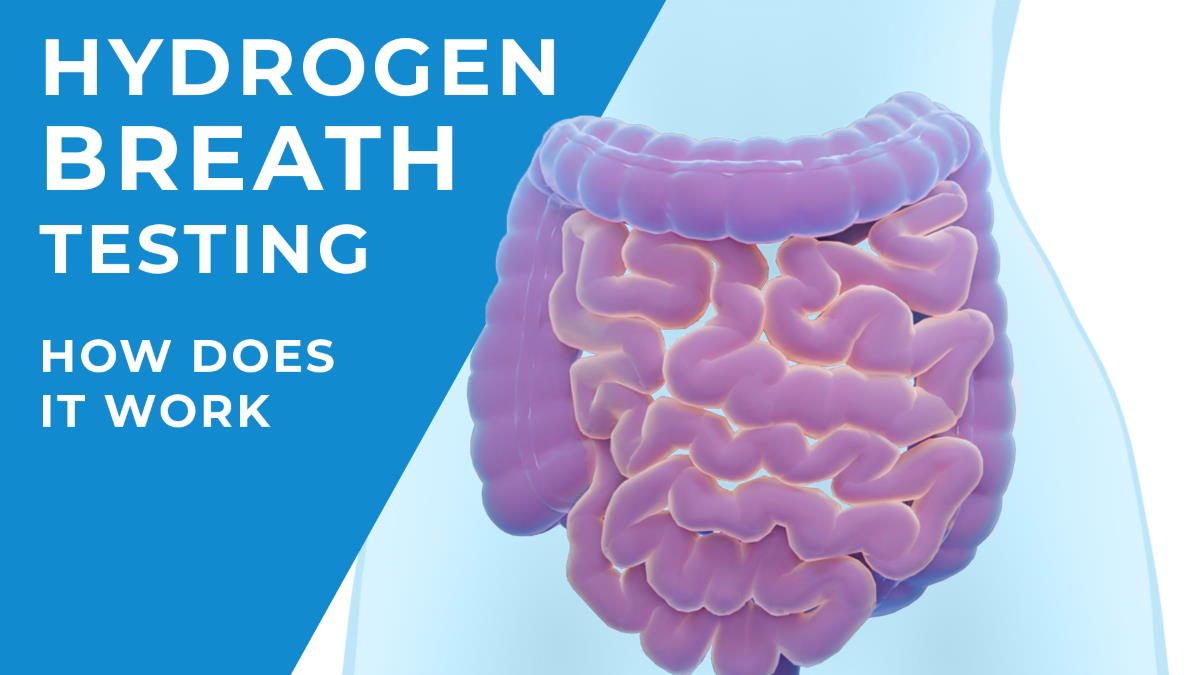The market for lactose-free and plant-based milks is flourishing. There are now more plant-based milk alternatives than I can count! It seems every day I walk into a health food store and some new nut or bean is available in milk form. With such a wide selection, it can be a little mind curdling!
So today I am going to look at some of the more common plant-based milks, and also a couple of the emerging newbies to the scene. I’m going to compare them in terms of nutrition to whole fat dairy milk. For those suffering with IBS I will also discuss the FODMAP content; even milks made out of low FODMAP plant alternatives can contain ingredients that make them high FODMAP.
The FoodMarble Taste Test!
For a bit of fun, I challenged some of the FoodMarble team to a blind taste test, to see how many they could identify. Considering the team, I figured that the best way to get them to try a variety of mystery milks was to mix it with coffee! Indeed, the idea of drinking seven cups of coffee had a lot of my colleagues excited. Each group of two had seven cups of half milk, half coffee placed in front of them and after trying all seven, they guessed each one. They got a point for each correct answer. The milks they tasted were:
- Pea milk
- Coconut milk
- Rice milk
- Roasted almond milk
- Soya milk
- Tiger nut milk
- Lactose-free dairy milk
Let’s see how they got on!
So…What are plant-based milks?
Plant milks have been used for centuries, with almond milk and coconut milk used in cooking as early as the 13th century. In fact, a drink made from ground and sweetened tiger nuts called Horchata can be dated back to 1200 AD in northern Africa. These nuts originate from Spain. In modern times Horchata is more widely known as a Mexican rice-based drink, so some simple deduction leads us to the conclusion that the colonists from Spain who arrived in Mexico couldn’t find tiger nuts to make their drink and looked to rice as an alternative. They also added cinnamon to the mix and to this day it remains an incredibly popular drink in Mexico.
Plant milks are made by simply watering down a heated slurry, made by grinding the plant. However modern manufacturers try and re-create the texture and mouthfeel of dairy milk by adding some other ingredients. Depending on the situation some will also be sweetened to give a more pleasant taste.
Let’s get to know our taste test line-up
The line-up contains some old names that I’m sure you’ll recognize, and a couple of new boys on the block looking to take the market by storm. We start with a young sprout – gaining popularity among baristas – pea milk.
Pea milk
I first discovered this when I was getting coffee from a popular chain of Dublin coffee shops. I had asked for coconut milk for my americano and unfortunately, they were out. As the helpful server listed their non-dairy alternatives, I was intrigued when she said pea protein milk. Some further study since then has turned up more than a few brands offering pea milk. Its main nutritional claim apart – from being dairy free – is being very high in protein. The brand we bought also advertised less sugar and more calcium than dairy milk. Bold claims – let’s see how they stack up!
NB: Dairy milk can have different additives and different fat contents, but I’m taking nutritional values for whole fat milk from here.
Nutritionally this has basically the same protein content, less carbs, sugars and fats, and more calcium than dairy milk. A quick read of the packaging does say it has added calcium, something other dairy milk companies can do too, so it is hard to tell what the natural calcium content is. Looking at the ingredients, the main two are water and pea protein. The rest is oils, sweeteners, starches, emulsifiers, stabilsers, vitamins, salt, acidity regulators and flavourings.
In terms of taste, despite its lower sugar content than dairy, it is incredibly sweet – the milk is sweetened with cane sugar. It has an almost light brown colour. During the taste test it didn’t go down too well, with multiple people comparing it to play-doh. In terms of FODMAPs there has been no study on pea milk yet as it is such a new product to the market. Peas contain fructans and galacto-oligosaccharides (both FODMAPs) so the milk could contain these, but this milk appears to be based on the protein from peas. Since FODMAPs are carbohydrates, pea protein could have a lower FODMAP content. IBS sufferers proceed with caution.
Next up – coconut milk
Coconut milk can sometimes cause slight confusion, as there is also tinned coconut milk used in cooking. Tinned coconut milk is a thick cream, unlike what we naturally think of as a milk for drinking with coffee/cereals. This cream is made by grinding the white flesh of the coconut and soaking it in water and straining.
Looking at the carton of coconut milk, 40% of its content is this thick cream. It also has water, and coconut juice (also known as coconut water). After this it is made up of the usual additives: acidity regulator, calcium carbonate, sea salt, pectin and xanthan gum. The packaging has no strong nutritional claims, aside from no added sugar. So, let’s compare some nutritional information.
Nutritionally it is a low fat, low sugar alternative, however, without the added calcium it can’t live up to its dairy based counterpart’s level. The carton does not advertise its calcium level, however a quick Google search shows that the tinned coconut milk only has 38mg of calcium per 240ml, and this is a diluted version of that. Coconut milk also contains no protein so this might affect some people’s decision to drink coconut milk.
In the taste test, the coconut milk turned out to be less noticeable than I thought it would be. Going in, I assumed it would be easily identified by its distinct flavor. However only one group guessed it by flavor; another group guessed it by the bits of coconut pulp they saw in the coffee and the last group couldn’t guess this one. This milk is low FODMAP up to 180ml, so IBS sufferers should exercise portion control.
Next in line is rice milk
Here the ingredients are listed as water, rice extract, acacia gum, sunflower oil, lithothamnion calcareum algae and salt. The algae is a source of calcium carbonate, which has been an ingredient in all the milks so far. The packaging advertised that it’s high in calcium, a source of fibre and fat free. Let’s compare these claims to dairy milk.
This milk is indeed rich in calcium, equaling that of dairy milk. It is lower fat and has slightly less sugars as well. However, in terms of carbohydrates it is significantly higher, with over double the carbohydrate content. Also, similar to the coconut milk, it is very low in protein. Taste wise this is neutral, which makes sense when you think of rice, which doesn’t have a strong flavor. In terms of FODMAPs this should be low FODMAP up to around 200ml.
Next we have roasted almond milk
The company also offered unroasted flavor but we decided to try this one. The ingredients are water, almonds (2.3%), calcium, sea salt, locust bean gum, gellan gum (these last two stabilize the mixture), sunflower lecithin (emulsifier, giving a creamy texture) and vitamins. Helpfully the packaging warns that it may contain nuts. In terms of health claims, the side packaging boasts that it’s a source of vitamin E (note this is one of the added vitamins in the ingredients), low fat and unlike the others this milk advertises being easier to digest, having no lactose. Let’s compare it to dairy based milk.
This is indeed a low-fat alternative, but more surprising is the lack of carbs and sugar. Note the equal calcium content to dairy milk, due to being fortified with calcium. Finally, we can see a trend emerging regarding the protein content, with this also being very low. In terms of FODMAPs, almond milk is low up to 200ml as well. During the taste test no group identified this. I assumed (as with coconut) that the natural flavour would be strong enough to give this one away. This did not hold true – one group even remarked that they searched for the advertised “roasted” flavour, but to no avail.
Next up is one that a lot of people are probably familiar with – soya milk
In terms of ingredients this particular milk has water, soya beans (6.5%), tri-calcium phosphate (calcium enrichment), gellan gum (stabilizer), natural flavouring, and added vitamins. In terms of claims this packaging is much less ambitious and simply says that it’s a source of calcium and vitamins. From the ingredients we know these are mostly added rather than being naturally occurring. So, let’s compare this to dairy based milk.
Soya milk actually has a higher protein content than dairy milk, along with lower fat, carbs and sugars, and equal calcium. As long as you can deal with the lack of sweetness (you could buy sweetened, this one was unsweetened) this is a very good alternative to dairy milk; doing better or equaling the important stats of protein, fat and calcium, while also being drastically lower in sugars. The bad news for IBS sufferers is that soya milk is naturally high FODMAP, due to soya’s high FODMAP content (high in fructan and galacto-oligosaccharides). So, IBS sufferers beware.
Next on the list is tiger nut milk
I discussed tiger nuts at the start, and although they are not well known in Ireland, in other parts of the world they are commonplace. In terms of ingredients we see spring water, organic rice, organic tiger nuts (6%) and sea salt. This is one of the most “natural” milks in this list, with no stabilisers, emulsifiers and no fortification with vitamins/calcium. Without fortification it will be interesting to see how it compares to dairy milk.
Nutritionally this is not a great alternative; with no mention of a calcium content, a significantly higher carbohydrate content and much lower protein content. This milk has a distinct light brown colour, and quite an unique flavour. Only one group guessed it correctly – by using the logic that it didn’t taste like anything they had tried before! For IBS sufferers this should be a good alternative; tiger nuts are low FODMAP as is rice which are the major ingredients.
Finally, we shall review lactose-free dairy milk
While this is not a plant-based milk, it is a viable low lactose alternative for people who are avoiding or reducing their lactose intake. Note that because this milk does come from cows and then has the lactose removed, you will not get the lower carbon footprint and environmental benefits of plant-based milks.
In terms of ingredients this particular brand has semi skimmed milk (90%), water and lactase enzyme. The only health claim on the packaging is that it is low fat. Let’s check its nutritional content.
We can see a close resemblance between the two in most of the nutritional stats, with it being lower fat as it used semi skimmed milk. Also, the sugar content is lower as lactose, a sugar, has been removed. Flavor wise, only one team successfully guessed this one during the taste test. As the lactose has been removed this should be safe for people avoiding FODMAPs.
So, which milk is right for me?
That’s a lot of data and discussion of mostly non-dairy alternatives, but the question remains, which one should you use? The answer to this all depends on your needs and tolerances. If you are looking for the most complete substitute then pea milk or soya milk does the best job, depending on how much you care about carbohydrate content and other additives. Rice, lactose free and tiger nut milks are the best for IBS sufferers as they have the lowest FODMAP content. If your only requirement is to avoid lactose, all of these are great alternatives. With modern food science any nutritional short coming in calcium or vitamins can be improved with fortification.
FoodMarble AIRE is the world’s first personal hydrogen breath tester. It is a pocket-sized breath analysis device. It helps people with chronic digestive issues determine the foods that work best with their digestive system. To learn more about FoodMarble, visit foodmarble.com












